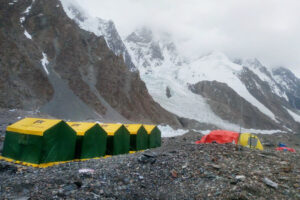Whether down a river, up a mountain, through a cave or across an ice cap, a world first sits atop every adventurer’s resumé. This is especially true if it has public appeal without being overly contrived. A journey involving the North or South Poles always has more potential to make a splash than an obscure arctic route, no matter how difficult. As we pointed out last year, the Explorers Grand Slam has lost its way, weakened by softening definitions. Maybe it’s time to explore a more original challenge: What does it take to climb to the highest point of every country on earth?
It is somewhat surprising that this challenge hasn’t already been achieved, or at least attempted more often. Instead, like Hollywood studios rolling out sequels, prequels and spin-offs, it’s far more common to see the same old routes refined (fastest, youngest, oldest).
Only one man has made a concerted effort to claim this mighty first, the enigmatically named Eamon Ginge Fullen. Since 1993, Fullen has allegedly summited the highest points in 170 countries, including all of Europe and Africa. Having dealt with Sudanese warlords and over-zealous Vatican guards, you might think that by now, he’s in the home stretch. After all, he’s only 50 years old. But despite his incredible total, he admits that he’s unlikely to finish. Fullen suffered a heart attack in his twenties while attempting Everest and so assumes that “there may be a height limit. I may never be able to climb all of them…but there is more than a lifetime’s worth of mountains. I am in no particular hurry.”

The ever-colorful Ginge Fullen decided that it would be a good idea to don a 1930s diving suit to climb Ben Nevis, the highest peak in the U.K. Photo: The Daily Record
But is there really more than a lifetime’s worth, or could this ultimate tick-list actually be achieved? Let’s set some parameters before we dig into the practical hurdles:
1. How many countries are we counting? This may seem like an easy question, but it depends on your definition of country and opinions about disputed territories. I’ve tried to keep it as straightforward as possible. We’ll take the 193 UN countries, the additional two Observer Nations, Palestine and Vatican City, and throw in Antarctica for good measure, although that entire continent is not technically even a single country. Anyway, this gives us 196 in total.
2. These 196 “countries” will not give us 196 separate high points. Mountains straddling international borders count as the high point for both countries, e.g. Everest counts for both China and Nepal.
3. The climbs must all be human-powered from the base of the mountain: no helicopter boosts allowed.
What are the biggest obstacles to success? First, there are the two biggest kahunas to climb.
The Big Kahunas
Everest, China/Nepal – 8,848m
K2, Pakistan – 8,611m

K2 can be reached from both Pakistan and China, though the Chinese side is significantly more difficult. Photo: Bartek Bargiel
Knocking the two over is a lifetime ambition for many climbers, but in our challenge, it’s only the start. Next up, the world’s third highest mountain, plus a handful of only slightly less imposing 7,000m+ peaks.
Technically Tough, Very High
Kangchenjunga, India – 8,586m
Gangkhar Puensum, Bhutan – 7,570m
Ismoil Somoni, Tajikistan – 7,495m
Noshaq, Afghanistan – 7,492m
Jengish Chokusu, Kyrgyzstan – 7,439m
Khan Tengri, Kazakhstan – 7,010m

Ismoil Somoni has gone through a few names. In 1933, it was named Stalin Peak before becoming Communism Peak in 1962. It was renamed Ismoil Somoni in 1998. Photo: Adventure Peaks
The world’s third largest peak has a death to summit rate of about 22%, so Kangchenjunga is clearly no walk in the park. But Bhutan’s Gangkhar Puensum might prove the trickiest of this bunch. Perhaps the highest unclimbed peak in the world, it has only been attempted four times and has been off-limits since 1994 to protect local spiritual beliefs. All the other peaks are possible, but you’ll need some serious cash, skill, time and luck to pull them off.

Bhutan’s Gangkhar Puensum. Since 2003, mountaineering has been forbidden throughout the country.
Our next batch of peaks are defined not by technical difficulty, but rather by their logistical impediments.
Logistical Nightmares
Logistical nightmares come in all shapes and sizes. There are countries beset by war or terrorist insurgencies, countries with obstructive bureaucracies and those that are just inconveniently tough to get to. We’ve highlighted a few in each category.
War/Failed States
Mont Ngaoui, Central African Republic – 1,410m

It’s tough even to find a photo of the Central African Republic’s Mont Ngaoui. Could this be it? Photo: Richard McClatchey
The Central African Republic has not been having a good time of it. A civil war has bubbled away since 2012, with widespread armed insurrections and inter-ethnic violence. Even Pope Francis took extensive security precautions when he visited in 2015. Four thousand United Nations troops were deployed to protect him during his visit, and his Popemobile is bullet-proof.
Emi Koussi, Chad – 3,445m

Over 60km wide, Emi Koussi is no ordinary volcano. Photo: David Evans
Surrounded by troublesome neighbors and fighting a terrorist uprising in the north, Chad’s government has a lot on its plate. Emi Koussi, a 3,445m shield volcano and tallest mountain in the Sahara, lies deep in the danger zone. Ticking Chad off the list might require a small army. Ginge actually managed this one, describing “no major problems…barring landmines, rebels, being off-limits and unclimbed in several years.”
Mount Hermon, Syria – 2,814m

Soldier cutouts overlook Mount Hermon, Syria. Photo: Shay Levy/Flash 90
Although Donald Trump has declared victory over ISIS, and the international community has shifted its focus elsewhere, Syria remains very much at war. Getting a visa is half the battle. My own experience crossing into Syria from Jordan involved seven hours of questions, confusion and calls “to Damascus”, and that was pre-war. If you are lucky enough to gain entry, you’ll still need to reach Mount Hermon while avoiding landmines and air strikes.
Jabal An-Nabi Shu’ayb, Yemen – 3,666m

A village at the base of Yemen’s highest mountain. Photo: Brian J. McMorrow
Torn apart by a proxy war between Saudi Arabia and Iran, Yemen has fallen far enough to be described as “the most wretched place on earth” by The Economist, low praise indeed. Professional traveler Johnny Ward has visited every country on the planet and described getting into Yemen as one of the toughest visa processes, requiring persistence and luck. Eventually, a chance meeting with a Yemeni refugee in Oman helped him find the internal contacts to snag a visa.
I Fought the Law and the Law Won
Paektu Mountain, North Korea – 2,750m

An aerial view of Paektu Mountain and its caldera lake in North Korea.
Want to achieve “precious mental pabulum more powerful than any kind of nuclear weapon”? Then you’ll need to follow Supreme Leader Kim Jong-Un’s lead and climb North Korea’s highest peak. Considering it is a sacred place in Korean folklore, and that visits to North Korea are more strictly controlled than anywhere on earth, you might have to risk imprisonment (or worse) to bag this one.
Aýrybaba (or officially Beýik Saparmyrat Türkmenbaşy belentligi), Turkmenistan – 3,138m

It is possible! Though it would probably be easier to just go and see the world’s largest indoor ferris wheel in Ashgabat instead.
Another mountain, another hermit kingdom; Turkmenistan’s highest point might prove just as difficult as North Korea’s. Visas are usually granted with enough application time, but you’ll need a tour guide in order to leave the capital of Ashgabat, and they’ll probably have to come up the mountain with you, too. This is the sort of dysfunctional, wacko-dictator country where a former leader officiallly renamed the word “bread” after his mother and the months in the year after other family members.
Unnamed location, The Vatican – 76m

Don’t mess with the Pontificial Swiss guards: They are still bitter about having to wear these uniforms. Photo: Periko, Trek Earth
Another strictly controlled country, The Vatican’s highest point measures a mere 76m. The problem might be finding it. Unnamed and presumably unmarked, you had better hope that the country’s highest point is somewhere tourists are allowed to wander.
Where on earth is that?
Mount Ngerchelchuus, Palau – 242m

Typical Pacific islands, but hardly typical mountains. Photo: The Independent
The many tiny Pacific island nations are not on many climbers’ radars. Nevertheless, if you want to notch every country in the world, you’re going to need to learn all their names. At least Palau’s highest point has an impressive-sounding moniker.
Mount Kinyeti, South Sudan – 3,187m

Trekking the forest of Mount Kinyeti. Photo: Marco Di Lauro
If you haven’t bought a new globe or atlas for a while, you might be in for a shock. That’s right, there are two Sudans now, and you’ll need to climb a mountain in both. Unfortunately, this entry could easily have been included in the War/Failed States section. The world’s newest country has been beset by civil war since its independence in 2011.
The quest to climb all 196 high points, however, is not all doom and gloom. A few peaks are pleasingly attainable:
The Cake Walks
Unnamed location on Villingili Island, The Maldives – 2m

Current sea level increases suggests that the Maldives may be underwater within 80 years. Photo: Go World Travel
The lowest high point in the world! The 2m mountain of the Maldives is, not surprisingly, unnamed. Peakbaggers are advised not to think too hard about rising sea-levels.
Buurgplaatz, Luxembourg – 558m

You don’t even need to climb the tower. Buurgplaatz, Luxembourg. Photo: Wikipedia
Luxembourg has the highest GDP per capita of anywhere in the world, a good spot to get a taste for the high life. You can hop over from Luxembourg City on a morning and waltz up its highest “mountain”, and you’ll be back in time for lunchtime champagne.
Vaalserberg, Netherlands – 322m

The views aren’t anything to write home about. Vaalserberg, Netherlands.
Technically, you don’t need to leave the carpark for this one. The hardest part of your climb will be swinging open the car door.
Among the many hurdles of this project, we haven’t even mentioned popping down to Antarctica to tackle Mount Vinson, or the five 6,000m+ peaks you need to climb in South America (Aconcagua in Argentina, Ojos del Salado in Chile, Huascaran in Peru, Nevado Sajama in Bolivia and Mount Chimborazo in Ecuador). Clearly, this is going to be a gargantuan challenge.
South African explorer Mike Horn agreed that “the potential impact humans can have on this type of challenge” through visas, permits and geopolitics might prove as difficult as the physical skills required to reach the summits of Everest, K2 and Kangchenjunga. Horn also discussed the role that weather and luck play. “If the weather is not in your favour, the expedition has a slim chance at success,” he points out. Horn knows whereof he speaks: along with his successes, he failed on K2 in 2015 and on Nanga Parbat last year. Imagine having to return to some of these mountains several times in order to mark them off the list.

In 2015, Mike Horn had to turn back on K2 because of poor weather. Photo: Mike Horn
Finally, this project takes money, heaps of it. Johnny Ward’s odyssey to visit every country on earth cost him a couple of hundred thousand dollars. That was “absolute bargain basement: hostels, overland rather than flights, backpacking etc.” An elite mountaineer will need to spend more than this: You don’t want to tackle K2 after three months of bedbugs, 48-hour bus journeys and noodles twice per day.
So the challenge may be less achievable than I first thought. Besides a few hundred thousand dollars and several years away from work, you’ll have to break the law more than once. Still, it would all be worth it for a world first, right?






